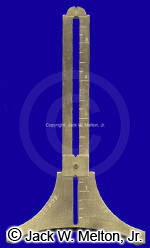 had
a graduated scale of tangents and a movable slide that could be tightened
down at any location on the scale. It was attached to a circular band which
rested on the breech. When aiming the weapon, the gunner placed the sight on
the breech and lined up the front sight with the slide. The range was then
calculated and the gun elevated to the appropriate degree reading.
had
a graduated scale of tangents and a movable slide that could be tightened
down at any location on the scale. It was attached to a circular band which
rested on the breech. When aiming the weapon, the gunner placed the sight on
the breech and lined up the front sight with the slide. The range was then
calculated and the gun elevated to the appropriate degree reading.
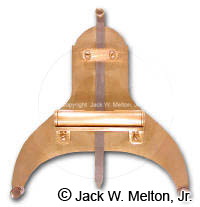 It
was made of sheet brass with the lower point cut in the form of a crescent.
The points of the crescent were made of steel. A small spirit level was
attached parallel to the points and a sliding scale was fastened
perpendicular to the axis of the level. The instrument was used to mark the
points of sight on siege guns and mortars when the platform was not level.
It
was made of sheet brass with the lower point cut in the form of a crescent.
The points of the crescent were made of steel. A small spirit level was
attached parallel to the points and a sliding scale was fastened
perpendicular to the axis of the level. The instrument was used to mark the
points of sight on siege guns and mortars when the platform was not level.
GUNNERíS QUADRANT: A graduated metal
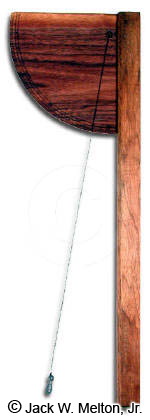 or
wood quadrant. The quadrant was a quarter of a circle (6-inch radius)
attached to a rule, 23.5-inches long. A plummet, or plumb-line and bob, was
attached to the center of the curve. The quadrant was used to determine the
required degree of elevation of the piece.
or
wood quadrant. The quadrant was a quarter of a circle (6-inch radius)
attached to a rule, 23.5-inches long. A plummet, or plumb-line and bob, was
attached to the center of the curve. The quadrant was used to determine the
required degree of elevation of the piece.
PENDULUM-HAUSSE SIGHT: Also called the Hausse Sight. A free-swinging sighting piece attached to a seat on the barrel near the breech.
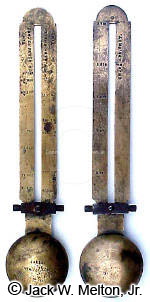 The sight consisted of an upright
piece of sheet brass with a movable slider. The slider traveled along a
graduated scale. At the lower end of the sight was a lead-filled bulb which
allowed the scale to remain in a vertical position regardless of the rough
ground or the trunnions. This allowed the pendulum-hausse sight to be used
when the breech sight and tangent scale were affected by a faulty position
of the trunnions. Each pendulum-hausse sight was made to fit a specific
weapon type.
The sight consisted of an upright
piece of sheet brass with a movable slider. The slider traveled along a
graduated scale. At the lower end of the sight was a lead-filled bulb which
allowed the scale to remain in a vertical position regardless of the rough
ground or the trunnions. This allowed the pendulum-hausse sight to be used
when the breech sight and tangent scale were affected by a faulty position
of the trunnions. Each pendulum-hausse sight was made to fit a specific
weapon type.
TANGENT SCALE OR SIGHT: A rear sight made of sheet
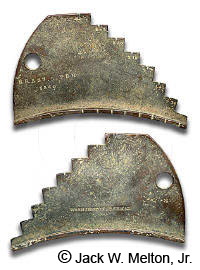 brass
cut into a series of steps with degrees marked on each step. Each degree
represented a known range for that weapon. A flange was located on the
curved base so that the sight could rest on top of the base ring. The
tangent scale was used in conjunction with the front sight and the system
required absolutely level trunnions. The tangent sight saw little service
during the Civil War and was replaced, to a great extent, by the pendulum
hausse or breech sight.
brass
cut into a series of steps with degrees marked on each step. Each degree
represented a known range for that weapon. A flange was located on the
curved base so that the sight could rest on top of the base ring. The
tangent scale was used in conjunction with the front sight and the system
required absolutely level trunnions. The tangent sight saw little service
during the Civil War and was replaced, to a great extent, by the pendulum
hausse or breech sight.